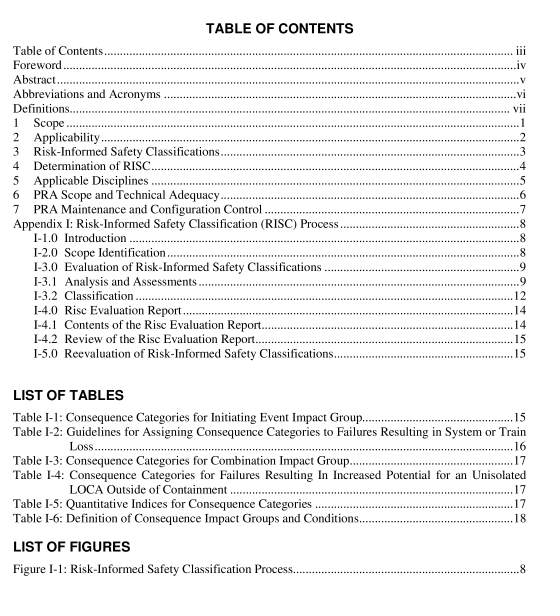ASME NTB-5 pdf download

ASME NTB-5 pdf download Guidance for Determination of Risk-Informed Safety Classification for Light Water Reactor Nuclear Facility Pressure Retaining Components
3RISK-INFORMED SAFETY CLASSIFICATIONS
(a) The RISC process is described in Appendix I of this document.Pressure-retaining items should be
classified high-safety significant (HSS) or low-safety significant(LSS), except as noted in 3(b) below.(b)(1) Class 1 portions of the reactor coolant pressure boundary (RCPB) that do not meet (i) or (ii)
below:
(i)in the event of postulated failure of the component during normal reactor operation, the reactorcan be shut down and cooled down in an orderly manner,assuming makeup is provided by thereactor coolant makeup system.
(1i) the component is or can be isolated from the reactor coolant system by two valves in series(both closed, both open, or one closed and the other open). Each open valve must be capable ofautomatic actuation and, assuming the other valve is open, its closure time must be such that, in theevent of postulated failure of the component during normal reactor operation, each valve remainsoperable and the reactor can be shut down and cooled down in an orderly manner, assuming makeupis provided by the reactor coolant makeup system only.
(2)ASME Boiler and Pressure Vessel Code,Section III, Class 1 items,that portion of the Class 2feedwater system [> NPS4(DN 100)] of Pressurized Water Reactors (PWRs) from the steam generatorto the outer containment isolation valve, and
(3) items that are within a break exclusion region3 [> NPS 4(DN 100)] for high-energy piping systemsand their associated supports (NB, NC and NF) should be classified high-safety significant (HSS).
4 DETERMINATION OF RISC In accordance with NCA-2110(c), the Owner, or his designee, should be responsible for providing system safety criteria to classify equipment in the nuclear power plant. This responsibility includes providing appropriate RISC classification in accordance with Appendix I of this document. In addition to the requirements of NCA-3252, the Design Specification should contain or reference the RISC Evaluation Report (I-4.0) and this document.
5 APPLICABLE DISCIPLINES
Personnel with expertise in the following disciplines should be included in addressing 1-3.2.2,1-3.2.3 andI-4.2 of the RISC classification process.
(a) probabilistic risk assessment (PRA)(b) plant operations
(c) system design
(d) safety or accident analysis
Other disciplines may be added, such as materials engineering,chemistry, or nondestructive examination,relevant to the specific system or equipment issues. Personnel may be experts in more than one discipline,but are not required to be experts in all disciplines.For new system or equipment designs, where there islimited service experience, personnel with expertise from similar plant designs (e.g., earlier or sameversions or models) should be used.
To qualify as an expert, personnel should be experienced in the applicable discipline and related nuclearpower plant requirements, and in the application of the requirements of the Code relating to the applicablediscipline.Personnel selected for their expertise should have a minimum of four years of varied nuclearapplication experience, including 2 years in the applicable discipline for which they are serving as an expert.This experience should indicate that the expert has sufficient knowledge of anticipated plant and systemoperating and test conditions and their relationship to Code design criteria pertinent to the applicable Codeitem. In addition, the expert should be knowledgeable of the specific Code requirements pertaining to hisspecialty field. Guidelines reflecting the appropriate degree of Code knowledge are contained in ASMESection III, Division 1,Appendix XXIII “Guide B – Nonmandatory Guidelines for Establishing CodeKnowledge.”
6 PRA SCOPE AND TECHNICAL ADEQUACY The PRA should be of sufficient scope and level of detail to support the RISC process, including verification of assumptions on equipment reliability from equipment not within the scope of this document. The PRA should be subjected to a review process where it is assessed against a standard 4 or set of acceptance criteria that is accepted by the regulatory agency having jurisdiction over the plant site. All deficiencies identified that impact the RISC process should be reconciled during the analysis to support the RISC process. The resolution of all PRA issues that impact the RISC process should be documented. EPRI report 1021467-A (Nondestructive Evaluation: Probabilistic Risk Assessment Technical Adequacy Guidance for Risk- informed In-Service Inspection Programs, Palo Alto, CA: 2011. 1021467) provides one example of addressing PRA completeness.









